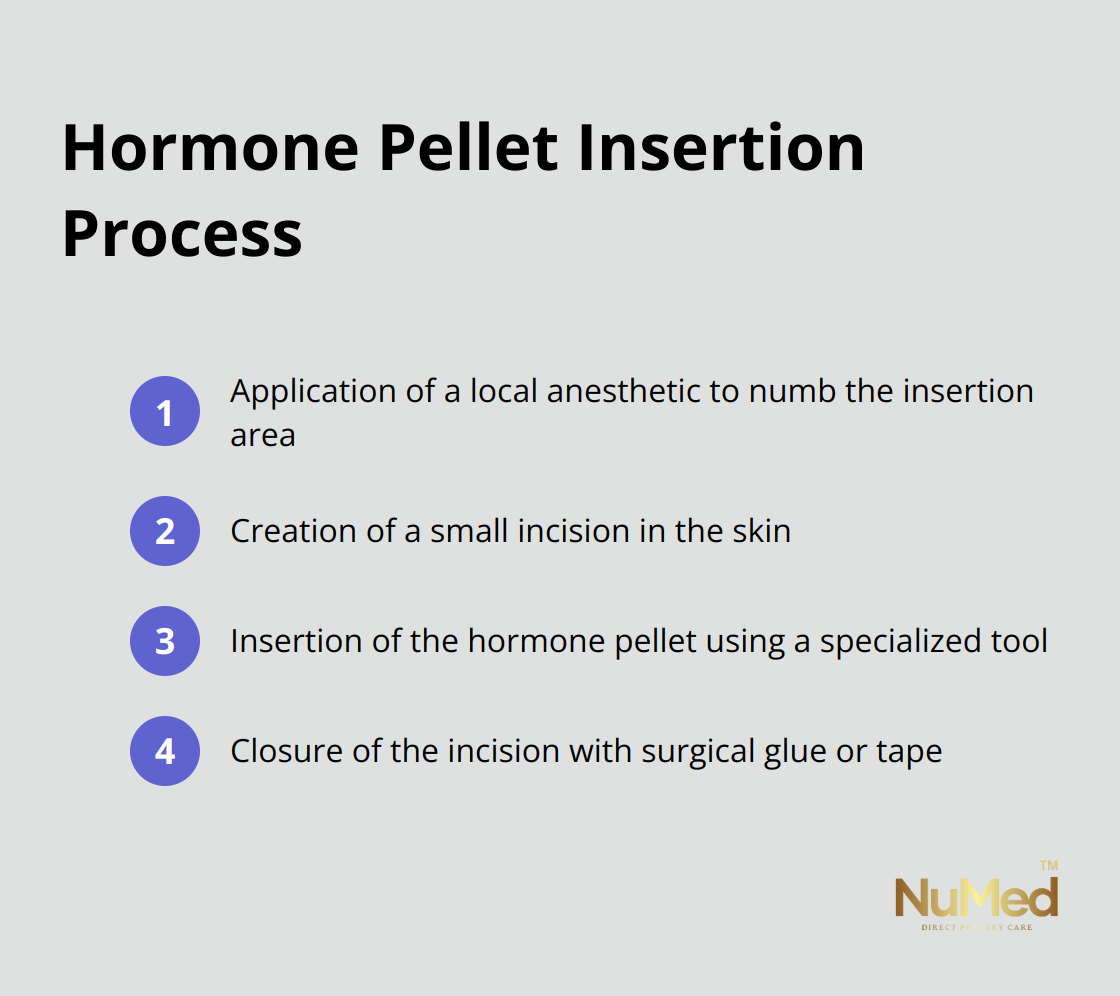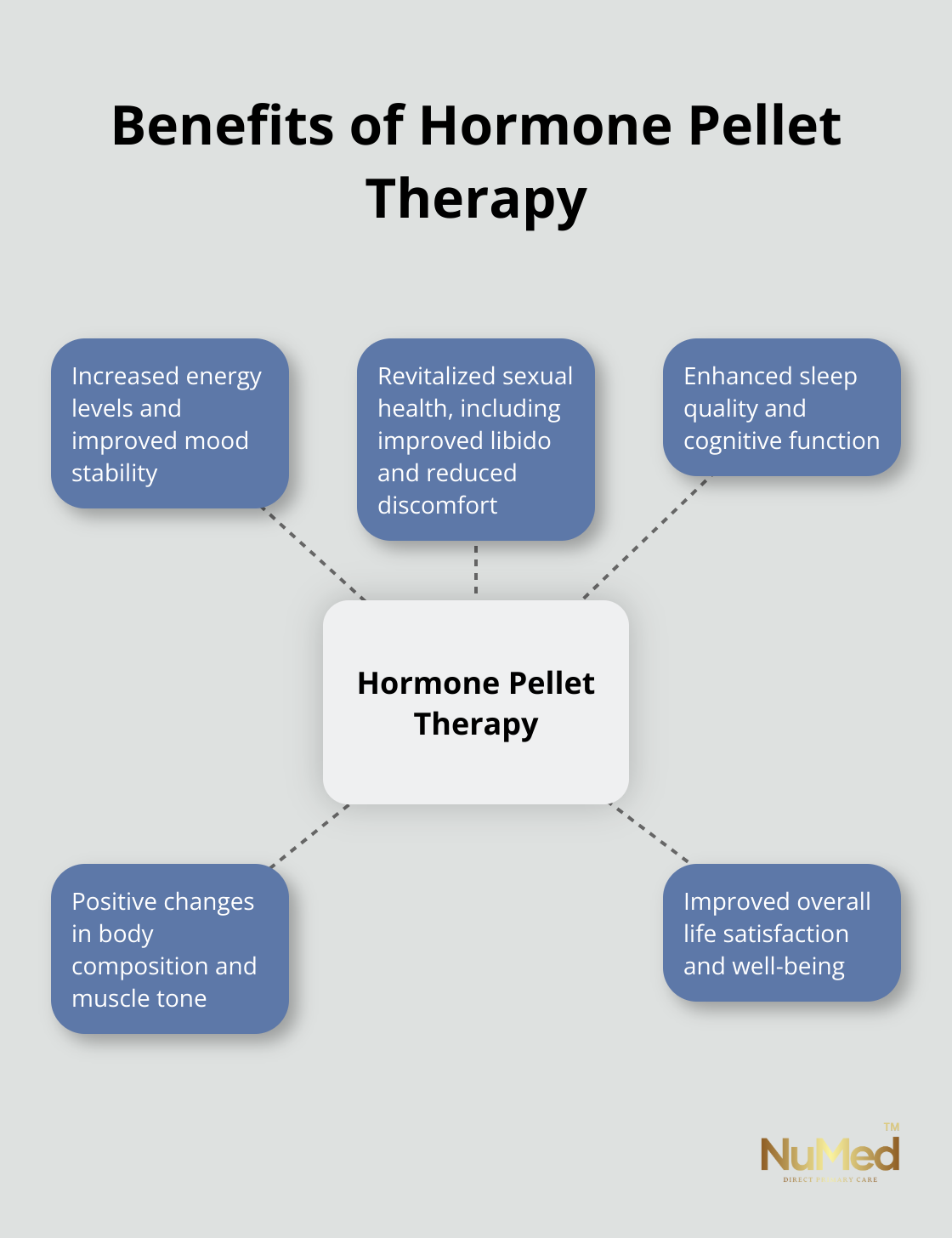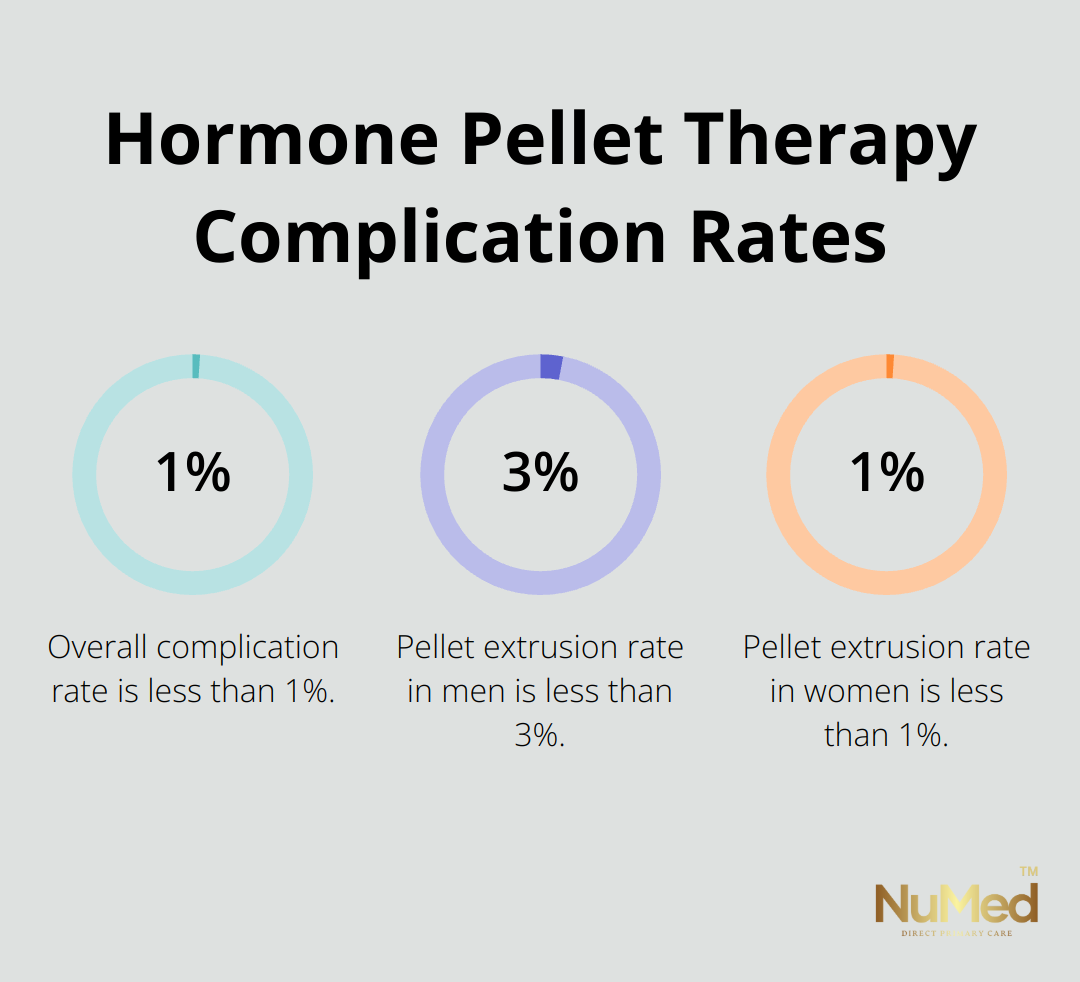At NuMed DPC, we’ve seen firsthand how hormone pellet therapy can transform lives. But don’t just take our word for it.
In this post, we’ll explore real hormone pellet therapy reviews from patients who’ve experienced this treatment. We’ll cover both the positive outcomes and potential drawbacks, giving you a balanced view of what to expect.
What Are Hormone Pellets?
The Basics of Hormone Pellet Therapy
Hormone pellet therapy represents a cutting-edge approach to bioidentical hormone replacement therapy. This treatment option attracts patients who seek relief from hormonal imbalances and want to avoid daily medication routines.
Composition and Function
Hormone pellets are tiny, cylindrical implants (about the size of a grain of rice). A healthcare provider inserts these pellets under the skin, typically in the hip area. Once in place, the pellets release hormones into the bloodstream over several months.
These pellets contain bioidentical hormones, which match the chemical structure of hormones produced naturally by the body. Women’s pellets often include estradiol and testosterone, while men’s pellets typically contain testosterone.
The Insertion Process
The insertion procedure takes approximately 15 minutes. Here’s what patients can expect:

Recovery and Duration
Most patients recover quickly from the insertion procedure. They can resume normal activities within a day or two, but should avoid strenuous exercise for about a week.
One significant advantage of pellet therapy is its long-lasting effects. A single pellet insertion can provide consistent hormone levels for 3-6 months (depending on individual metabolism and hormone needs).
Pellets vs. Other Hormone Replacement Methods
Pellets offer several advantages over other hormone replacement methods:
- Steady hormone release (mimics the body’s natural processes)
- Potentially fewer side effects
- No need for daily medication management
- More consistent hormone delivery compared to injections
However, it’s important to note that pellet therapy isn’t reversible once inserted. If side effects occur, they may persist until the body fully absorbs the pellet.
Monitoring and Adjustments
Regular blood tests play a vital role in monitoring hormone levels and adjusting future pellet doses. Healthcare providers typically schedule follow-up appointments every 3-4 months to ensure optimal hormone balance.
While hormone pellet therapy can offer significant benefits, it’s not suitable for everyone. A thorough medical evaluation and discussion of health goals are essential before starting any hormone replacement therapy.
As we move forward, let’s explore real patient experiences with hormone pellet therapy, both positive and negative, to provide a comprehensive view of this treatment option.
Real Patient Experiences with Hormone Pellet Therapy
Energy and Mood Transformation
Hormone pellet therapy often leads to a significant increase in energy levels. Combining MHT and structured exercise is most effective for enhancing BMD in menopausal women. This boost in vitality frequently correlates with improved mood stability. Patients often describe feeling more optimistic and emotionally balanced, with fewer instances of irritability or mood swings.
Revitalized Sexual Health
One of the most celebrated benefits of hormone pellet therapy is its impact on sexual function. A 58-year-old male patient stated, “My libido has returned to levels I haven’t experienced in years.” Women often note increased arousal and reduced discomfort during intercourse. These improvements can profoundly affect intimate relationships and overall life satisfaction.

Enhanced Sleep and Cognitive Function
Sleep disturbances often plague those with hormonal imbalances. After starting pellet therapy, many patients report easier sleep onset and more restful sleep throughout the night. This improved sleep quality often translates to better cognitive function during the day. A 45-year-old executive noted, “My mental clarity and focus at work have significantly improved since starting pellet therapy.”
Physical Composition Changes
While hormone pellet therapy doesn’t primarily target weight loss, many patients observe positive changes in their body composition. Some report an easier time maintaining a healthy weight, while others notice improvements in muscle tone and strength. A 60-year-old patient shared, “I’ve lost stubborn belly fat and gained lean muscle mass, even though my exercise routine hasn’t changed dramatically.”
Individual Variations and Monitoring
It’s important to note that while these positive experiences are common, individual results can vary. Factors such as age, overall health, and lifestyle choices all play a role in the effectiveness of hormone pellet therapy. Regular follow-ups and hormone level monitoring (typically every 3-4 months) are essential for optimizing treatment outcomes.
As we explore these positive experiences, it’s equally important to consider potential side effects and negative reviews. This balanced perspective will help you make an informed decision about whether hormone pellet therapy aligns with your health goals.
What Are the Drawbacks of Hormone Pellet Therapy?
Adjustment Period Challenges
The initial weeks after pellet insertion can present challenges for some patients. During this time, hormone levels adjust, which can lead to temporary side effects. These may include mood swings, acne flare-ups, or changes in sleep patterns. A 42-year-old female patient reported, “The first month was rocky. I experienced mood swings and insomnia, but these issues resolved as my body adjusted.”
Insertion Site Complications
While rare, complications at the insertion site can occur. A recent study found that the overall complication rate was <1%. The most common secondary response reported was pellet extrusion, which was more common in men (<3%) than women (<1%). Patients must follow post-insertion care instructions meticulously to minimize these risks.

Hormone-Related Side Effects
Some patients experience side effects related to hormone fluctuations. These can include:
- Acne or oily skin
- Unwanted hair growth
- Headaches
- Breast tenderness (in women)
- Testicular shrinkage (in men)
These side effects often diminish as the body adjusts to the new hormone levels. Regular follow-ups with a healthcare provider are essential to address any persistent issues.
Ineffective Treatment Cases
While many patients see significant improvements with hormone pellet therapy, it does not prove effective for everyone. Factors such as individual metabolism, overall health, and lifestyle can influence treatment outcomes. A 55-year-old male patient shared, “After six months, I didn’t notice the energy boost or libido increase I hoped for. My doctor and I decided to explore other options.”
In cases where pellet therapy proves ineffective, alternative hormone replacement methods or lifestyle interventions may be more suitable. Healthcare providers work closely with patients to find the most effective treatment plan, adjusting as needed based on individual responses and preferences.
Long-Term Commitment and Irreversibility
Hormone pellet therapy requires a long-term commitment. Once inserted, the pellets cannot be removed, and their effects will continue until the body fully absorbs them (typically 3-6 months). This lack of reversibility may include a slight possibility of infection or the pellets shifting or expelling, which could lead to some discomfort after the surgery.
The effectiveness of hormone pellet therapy can vary depending on the provider’s expertise and the quality of the pellets used. Choosing a reputable provider with experience in bioidentical hormone replacement therapy is important for optimal results and minimizing potential side effects.
Final Thoughts
Hormone pellet therapy offers a unique approach to addressing hormonal imbalances. Many patients report significant improvements in energy, mood, sexual function, and overall quality of life. However, this treatment also comes with potential drawbacks, including adjustment periods, insertion site complications, and possible hormone-related side effects.
We recommend a thorough consultation with a qualified healthcare provider before starting any hormone replacement therapy. At NuMed Direct Primary Care, we provide personalized assessments and comprehensive care to help you make informed decisions about your health. Our approach focuses on addressing root causes and tailoring treatments to your specific needs.
The decision to pursue hormone pellet therapy should involve careful consideration of hormone pellet therapy reviews and discussions with your healthcare provider. They can help you understand your hormone levels, explore potential alternatives, and create a treatment plan that aligns with your health goals (without making any unverified claims about our company).
















